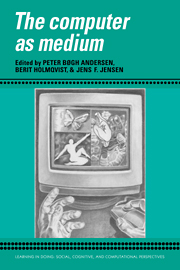Book contents
- Frontmatter
- Contents
- Series foreword
- Preface
- Contributors
- Part I Computer-based signs
- Introduction
- 1 A semiotic approach to programming
- 2 Structuralism, computation, and cognition: The contribution of glossematics
- 3 The shortest way between two points is a good idea: Signs, Peirce, and theorematic machines
- 4 Logic grammar and the triadic sign relation
- 5 Meaning and the machine: Toward a semiotics of interaction
- Part II The rhetoric of interactive media
- Part III Computers in context
- Index
2 - Structuralism, computation, and cognition: The contribution of glossematics
Published online by Cambridge University Press: 05 October 2010
- Frontmatter
- Contents
- Series foreword
- Preface
- Contributors
- Part I Computer-based signs
- Introduction
- 1 A semiotic approach to programming
- 2 Structuralism, computation, and cognition: The contribution of glossematics
- 3 The shortest way between two points is a good idea: Signs, Peirce, and theorematic machines
- 4 Logic grammar and the triadic sign relation
- 5 Meaning and the machine: Toward a semiotics of interaction
- Part II The rhetoric of interactive media
- Part III Computers in context
- Index
Summary
This chapter is concerned with the intrinsic semiotic nature of a computer. We shall begin by sketching the principles of the computational paradigm of cognitive science in order to establish the cognitive relevance of the computer. Then we shall show that this cognitive relevance is also semiotically relevant by analyzing the glossematic relations, with particular reference to the “constant” concept. Finally, we shall define a “cognitive virtual machine” that specifies (a part of) the semiotic nature of a computational machine.
For nearly 40 years, the methodology of linguistics has been based on an “epistemology of refutation” (Popper, 1959; Milner, 1989). According to this epistemology, a theory is scientific only to the degree that it can be refuted. This claim can be summed up in the following two points:
(1) The theory must be expressed in unequivocal and calculable terms in order that theoretical descriptions can be submitted to a refutation test.
(2) The theory must contain operational methods for the refutation of hypotheses.
The framework of computer science satisfies these prerequisites in a coherent way: The general theory of formal languages – the principal foundation of computer science – allows a precise formulation of linguistic descriptions, and at the same level of formal analysis (the logico-algebraic level) it provides a device for evaluating linguistic theories, since the computer can process symbolic data automatically.
This epistemological position has pointed linguistic research in a certain direction: It assigns a test function to the computer system, and it forces linguists to choose a certain kind of formal description.
- Type
- Chapter
- Information
- The Computer as Medium , pp. 68 - 91Publisher: Cambridge University PressPrint publication year: 1994
- 1
- Cited by



